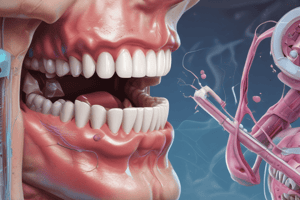Podcast
Questions and Answers
What is the term used to describe a red patch on the oral mucosa that cannot be attributed to any other diagnosable condition?
What is the term used to describe a red patch on the oral mucosa that cannot be attributed to any other diagnosable condition?
- Erythroplakia (correct)
- Actinic Keratosis
- Lichen Planus
- Candidal leukoplakia
What percentage of erythroplakia cases show severe dysplastic changes or carcinoma in situ?
What percentage of erythroplakia cases show severe dysplastic changes or carcinoma in situ?
- 20%
- 60%
- 80%
- 40% (correct)
What is the term used to describe a white plaque superimposed by candidal infection?
What is the term used to describe a white plaque superimposed by candidal infection?
- Erythroplakia
- Candidal leukoplakia (correct)
- Lichen Planus
- Actinic Keratosis
What is the term used to describe a condition caused by chronic sun exposure?
What is the term used to describe a condition caused by chronic sun exposure?
What is the term used to describe a condition that appears as bright red patches with velvety texture and irregular outline?
What is the term used to describe a condition that appears as bright red patches with velvety texture and irregular outline?
What percentage of erythroplakia cases are squamous cell carcinoma?
What percentage of erythroplakia cases are squamous cell carcinoma?
What is the term used to describe a condition that appears as white plaques superimposed by candidal infection?
What is the term used to describe a condition that appears as white plaques superimposed by candidal infection?
What is the term used to describe a condition that appears as a patch on the oral mucosa?
What is the term used to describe a condition that appears as a patch on the oral mucosa?
What is the term used to describe a condition caused by chronic candidal infection?
What is the term used to describe a condition caused by chronic candidal infection?
What is the term used to describe a condition that appears as focal white areas representing keratosis intermingling with red patches?
What is the term used to describe a condition that appears as focal white areas representing keratosis intermingling with red patches?
Flashcards are hidden until you start studying
Study Notes
Idiopathic Leukoplakia
- 15% of cases may undergo malignant transformation to verrucous carcinoma or squamous carcinoma
- Characterized by a verrucous and hyperorthokeratinized surface with so-called epithelial crypts
- epithelial cells extend below the level of the adjacent normal basement membrane, suggesting early development of verrucous carcinoma
Histologic Changes in Idiopathic Leukoplakia
- Vary from hyperkeratosis to dysplasia
- May exhibit abnormal epithelial growth and hyperorthokeratosis or hyperparakeratosis
- Graded as mild, moderate, or severe
- Mild dysplasia: alteration limited to the basal and parabasal layers
- Moderate dysplasia: involvement from the basal layer to the mid-portion of the prickle cell layer
- Severe dysplasia: involvement from the basal layer to a level above the midpoint of the epithelium
Invasive Carcinoma
- Begins when a focus of epithelial cells invades the lamina propria
- Spreads in a lateral direction, 1-2 mm beyond the basal lamina
- Characterized by loss of polarity, loss of epithelial cell cohesiveness, and abnormal mitotic figures
Cytological Changes in Idiopathic Leukoplakia
- At low power:
- Loss of polarity
- Loss of epithelial cell cohesiveness
- Bulbous or teardrop-shaped rete ridges and basal cell hyperplasia
- Keratin or epithelial pearls
- Loss of stratification
- At high power:
- Enlarged nuclei and cells
- Pleomorphic nuclei and cells
- Hyperchromatic nuclei
- Abnormal nuclear-cytoplasmic ratio
- Dyskeratosis
- Large and prominent nucleoli
- Increased mitotic activity
- Abnormal mitotic figures
Other Types of Leukoplakia
- Candidal leukoplakia: a white plaque superimposed by candidal infection
- Lichen planus: ???????????
- Actinic keratosis (solar keratosis): ???????????
- Actinic cheilosis (actinic chelitis, solar chelosis): ???????????
- Erythroplakia: a red patch on the oral mucosa that cannot be attributed to any other diagnosable condition
Erythroplakia
- Etiology: same as oral cancer
- Clinical features: bright red, velvety texture, homogeneous, irregular outline
- Histopathologic features: 40% of cases show severe dysplastic changes or carcinoma in situ, 50% of cases are squamous cell carcinoma
Studying That Suits You
Use AI to generate personalized quizzes and flashcards to suit your learning preferences.




